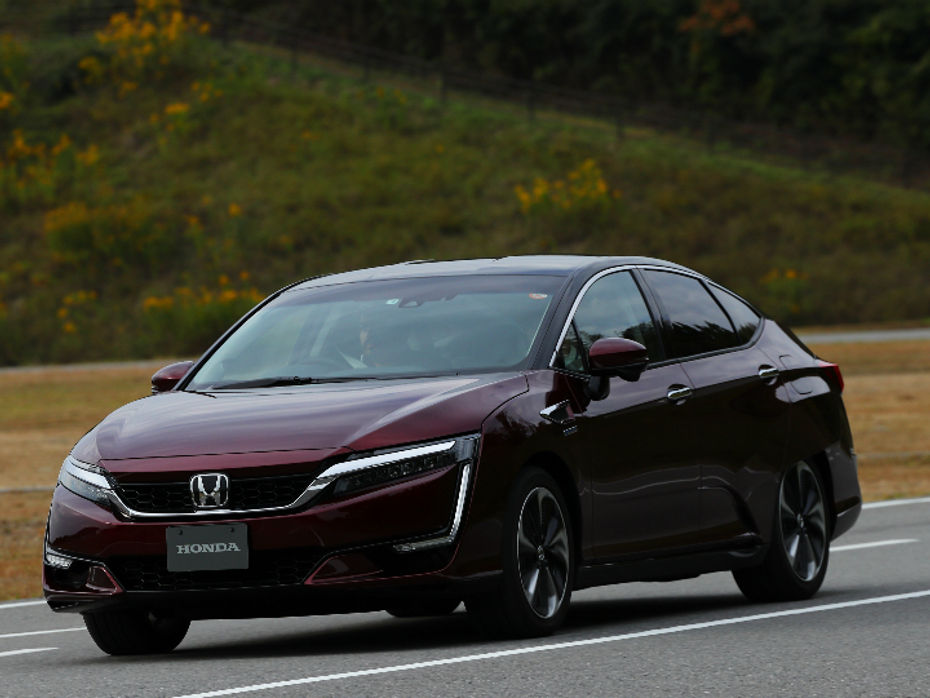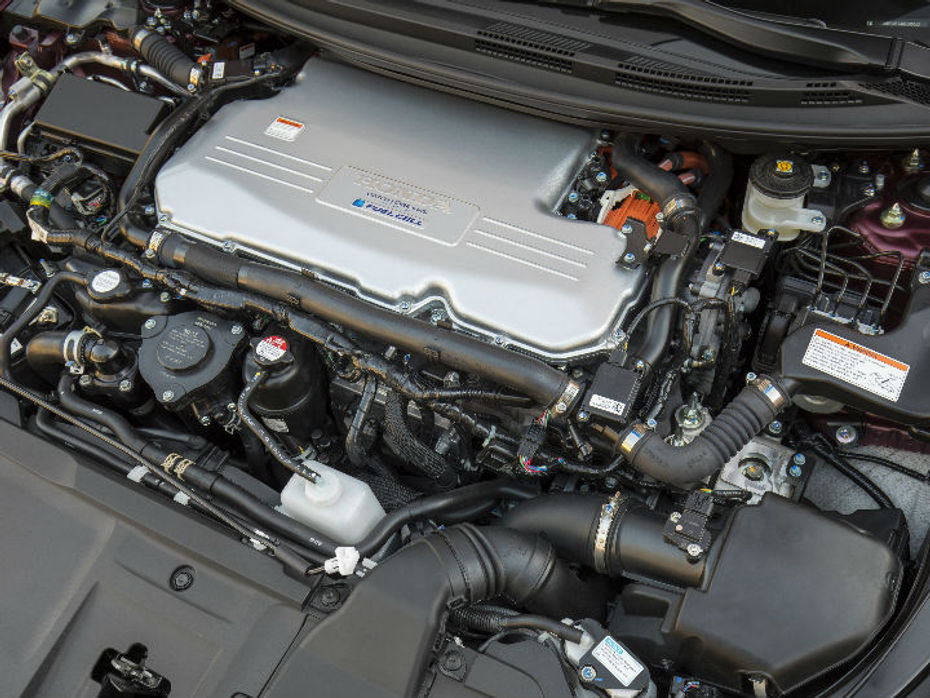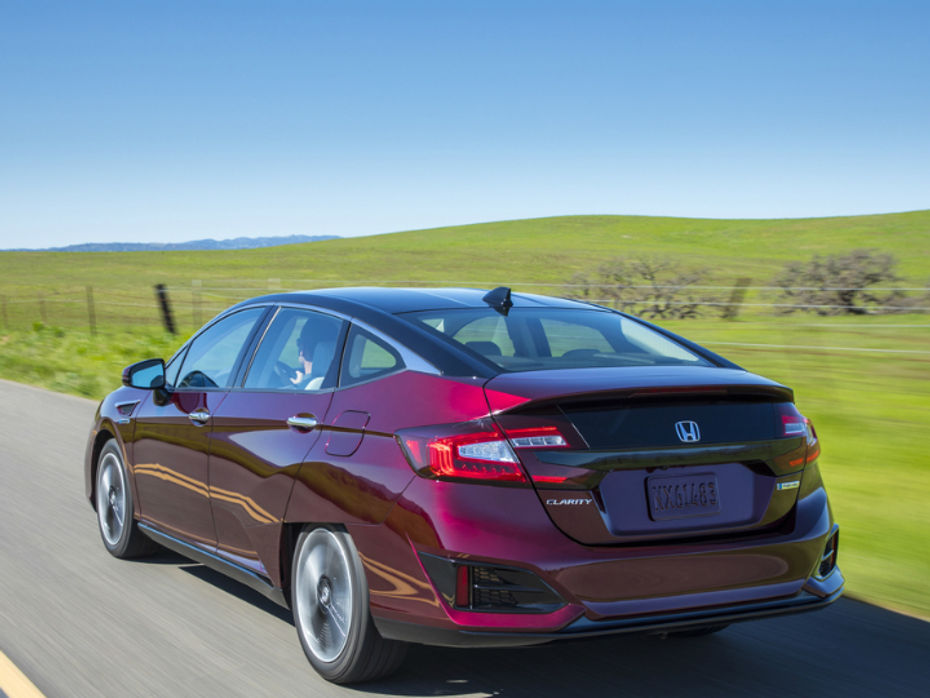 Here Are Some Adrenaline Pumping Experiences From Auto Expo 2025 That You Should Not Miss!
Here Are Some Adrenaline Pumping Experiences From Auto Expo 2025 That You Should Not Miss!
 Hyundai Creta Electric Reaches Dealerships, Check It Out In 9 Images!
Hyundai Creta Electric Reaches Dealerships, Check It Out In 9 Images!


The Honda Clarity is akin to a Swiss army knife. It’s a passenger car, it’s meant for a greener world. It promises a fun driving experience too and for those who find future-first car styling either too sombre or outlandish, it strikes a balance in design too. We experienced the car’s multiple avatars on Honda’s homeground, the Twin Ring Motegi test/race track in Japan, just for a taster.
The Silent Future
It doesn’t matter what version of the Clarity you’re in (FCV or PHEV), the soundless experience would make a pin-drop seem heavy metal loud (pun intended). Outside, when on the move, the Clarity FCV (Fuel Cell Vehicle) does emit a unique whirr, reminiscent of an old gaming console starting up. But inside, you and the passengers can enjoy some conversation unperturbed! The Clarity PHEV (Plug-in Hybrid Electric Vehicle), showcased at the 2017 Tokyo Motor Show, is understandably more audible, since it does get an Atkinson Cycle petrol engine too, but that may be a comfort to those transitioning from traditional fuel power. As Honda puts it, PHEV is for the ‘Mainstream’ green car buyer who wants lowered fuel consumption but can’t warm up to a major technology change just yet. Speaking of which...

Nature Pleased
Powered by an AC synchronous motor, the Clarity FCV delivers 177PS of power and 300Nm of torque. Adequate output, yes, but FCVs aren’t light. Tipping the scales at 1890kg, you’re looking at a power-to-weight ratio similar to some ladder-frame 7-seater SUVs. However, the direct drive to the front wheels, combined with a low slung, aerodynamic design and smart engineering turns the tables.
In fact, Honda claims a travel range in the ballpark of 700km with the 141-litre hydrogen tank fuelled up! What’s more, the high pressure (70 Mpa) hydrogen tank can be topped up in approximately 3 minutes! The byproduct of all this is good old-fashioned H2O.
Recommended Read:
Tokyo Motor Show 2017: Honda's Sports EV Is Gorgeous!
Shared DNA
The Clarity FCV and PHEV have similar internals too and both have the lithium-ion battery pack mounted to the floor for better space utilisation and weight balance, while the fuel tanks sit behind the rear seat.
In the plug-in hybrid, a 1.5-litre, 4-cylinder engine drives the wheels using a similar setup as the Accord Hybrid i.e. the combustion engine rarely has to drive the wheels directly and acts more like a generator. Under ideal conditions, it manages a pure EV range of nearly 100km. Having tested this with the India-spec Accord Hybrid, we can attest to the fact that Honda’s i-MMD (intelligent multi-mode drive) actually works in the real world.
Sensibility
The Clarity’s biggest draw is its claim of being a proper 5-seater family car. Even with a space-stealing component like the battery pack thrown into the mix, the Clarity manages to serve its primary purpose quite well. Honda has retained its traditional trait of maximising cabin space and with the battery integrated into the floorplan, it really is a car big enough for the whole family. With my 6.5ft frame, I could sit behind a driver 5.10ft tall but anything more and I’d be locked in place. That’s healthy barometer for regular-sized humans in our books. Seating three at the rear is convenient and there’s no dearth of practical spaces. Even with the fuel tank placed behind the rear seat, the boot’s big enough for full-sized suitcases.

Drive
Two laps of a test track don’t make for the best setting to pass judgement on a plug-in hybrid/fuel-cell vehicle’s competence but it is enough to tell you one important thing - driving these cars is easy. As complex as their underlying technologies may be, none of the wizardry makes the driving hard to master. Just select the drive mode like you would in a traditional automatic car and get going.
The pure electric start in either car is smooth and with the torque being available immediately, the Clarity, in any version, feels sprightly. There’s no hesitation to move quickly in the FCV, nor is there any hitch in the PHEV’s mode transitions. Both hit triple digits fast and show no perceptible strain when pushed hard. They corner pretty flat too and while these aren’t cars designed for the enthusiast, the steering does enough to keep you engaged.

Future Fun
The biggest fear for a fossil fuel purist is the loss of performance and excitement for the sake of efficiency. But Honda has a trick up its sleeve to prove that green doesn’t equate to a car that can’t be mean. Strip the door panels, lower the ride height and rework the FCV powertrain to get the Clarity FCV Racing.
This is Honda’s guilty pleasure, amid building one of the most flexible vehicle platforms in its history. The race-spec FCV delivers, forgive the cliche, the Ninja experience - silent but deadly. A taxi lap in the track car proved to tingle the senses and confuse at the first time. We’ve done hard driving plenty of times, but the one highlight every time is that pushing a car makes it get loud.
Here, though, your speed reference is limited to the rate at which the trees turn into a blur and how hard you’re pushed into the panel next to you. The car corners hard and with a pedal-happy driver at the helm, it doesn’t take more than just a few laps to render a fresh set of tyres useless. If there was ever a cure to EV-phobia, this would be it!

Takeaway
Honda's Clarity range is a conscious effort to keep the car alive and relevant in a world where the passenger car is often treated like an evil. Unfortunately, we in India aren't ready for hydrogen fuel supply and recent moves have left little hope for hybrids in any form. However, the Clarity does come with a pure EV too and given the packaging of the FCV and PHEV, there's potential for a new flagship sedan.
India's largest automotive community
 Here Are Some Adrenaline Pumping Experiences From Auto Expo 2025 That You Should Not Miss!
Here Are Some Adrenaline Pumping Experiences From Auto Expo 2025 That You Should Not Miss!
 All You Need To Know About The Surprise Element At Auto Expo 2025: BMW iX1 LWB
All You Need To Know About The Surprise Element At Auto Expo 2025: BMW iX1 LWB
 Hyundai Creta Electric Reaches Dealerships, Here’s A List Of Its Pros And Cons Before You Check It Out!
Hyundai Creta Electric Reaches Dealerships, Here’s A List Of Its Pros And Cons Before You Check It Out!
 MG Showcases A PHEV At Auto Expo 2025: The MG HS PHEV
MG Showcases A PHEV At Auto Expo 2025: The MG HS PHEV
 MG Astor First Drive Review: Standing Out In Style
MG Astor First Drive Review: Standing Out In Style
 2021 Mahindra XUV700: First Drive Review
2021 Mahindra XUV700: First Drive Review
 Kia Sonet Driven: More Than Just A Great Brochure?
Kia Sonet Driven: More Than Just A Great Brochure?
 Vayve Mobility Eva
Rs. 3.25 Lakh
Vayve Mobility Eva
Rs. 3.25 Lakh
 BMW X3
Rs. 75.80 Lakh
BMW X3
Rs. 75.80 Lakh
 Hyundai Creta Electric
Rs. 17.99 Lakh
Hyundai Creta Electric
Rs. 17.99 Lakh
 Lotus Emira
Rs. 3.22 Crore
Lotus Emira
Rs. 3.22 Crore
 Lotus Emeya
Rs. 2.33 Crore
Lotus Emeya
Rs. 2.33 Crore